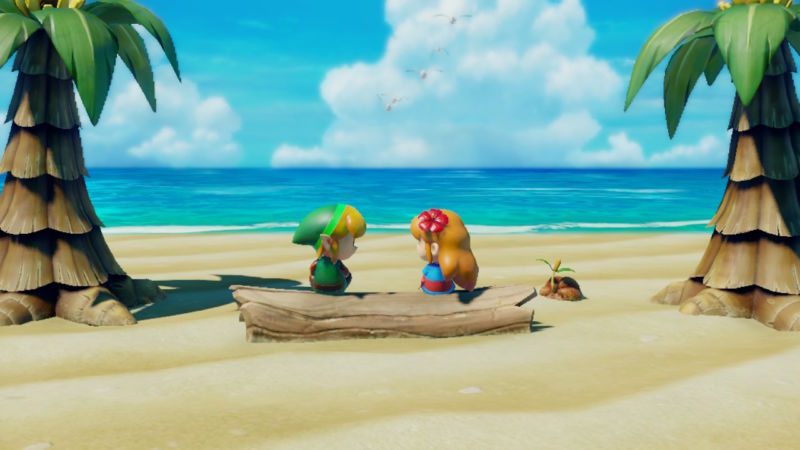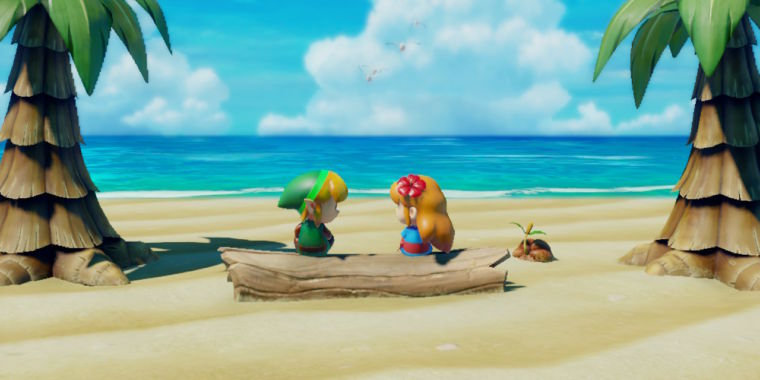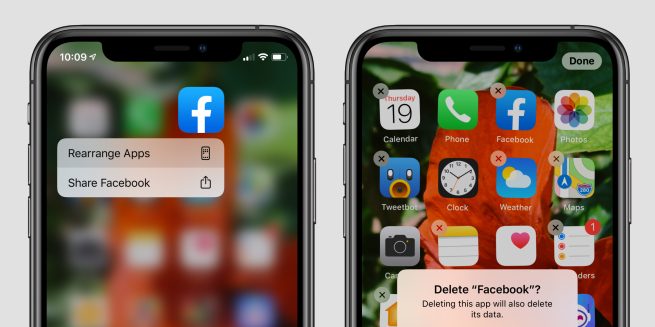
This year's remake of The Legend of Zelda: Link's Awakening, which debuted on the original Game Boy in 1993, stands alone in the company's re-release pantheon. No Nintendo game has ever returned with this much of a luxurious, jaw-dropping coat of audio-visual paint—while also gripping so fiercely to its original gameplay. As a result, you may not find a more polarizing first-party game on the Nintendo Switch.
Spoiler alert: It’s pretty much the same
-
The steps you'll take to reclaim your sword on Koholint Island's beach are identical to the Game Boy original.
-
Hoot's this? I mean, who's this? Prepare to have many chats with a mysterious owl.
-
No confirmation whether that means my filename of "BUTT" is indeed engraved on this sword.
-
Mabe Village is back. Yes, you can still steal from the above store, though it's trickier this time around.
-
The "Trendy Game" claw machine is back, but items move around differently this time. I'm not sure why they remixed it.
-
A very long fetch quest chain begins with this Yoshi doll. Take it to a sad mom and she gives you another item, which you give to the next person, and the next, and the next...
-
...and eventually, while taking items from one NPC to the next, you'll find the game's weirdest cameos, like this take on SimCity's Mr. Wright. (In 1993, he was still a "fresh" reference.)
-
Fishing returns, as well.
-
Every hint you get in the game is like this. Did you recall seeing a catfish's mouth anywhere? If so, this hint is great. If not, retrace your steps.
-
A very early peek at the map, which is easy to zoom into and out of—and place icons and markers onto, like in Breath of the Wild.
-
Need to backtrack to any hint you got in the game? This menu eventually becomes chock full of dialogue to refer to in a pinch.
-
Slashing pigs with a temporary power-up, just like in the original.
-
Hoot again? I mean, you again?
-
The game's seashell challenge will eventually see you digging into the ground all of the freaking time.
-
Into the dungeon we go.
-
No, the game never explains why Super Mario series enemies appear in the side-scrolling sections.
-
Familiar foes.
-
Mini-bosses look more dramatic this time, but they battle identically.
-
Making music in Mabe Village.
Let's be frank: You can spoil most of the new Link's Awakening by watching an existing YouTube playthrough of the Game Boy original. It's that allegiant to the source material, right down to the placement of terrain, enemies, and doorways. Need to solve a puzzle? Wondering where one of the game's "seashell" collectibles is hiding? Stuck on a boss's weak point? Go ahead, read an ASCII-formatted, decades-old walkthrough on a site like GameFAQs. It'll work.
Nintendo has rewound to a very specific adventure design era, somewhere between 1986's Legend of Zelda and 1991's Link To The Past, by re-releasing its final 8-bit Zelda game in such authentic fashion. What does that mean, exactly? On a basic level, this is top-down Zelda adventuring of old. You play as Link, an adventuring child in a green tunic who wakes up under mysterious circumstances. You proceed through a large overworld and its many dungeons to acquire keys and items while battling monsters and bosses. And many of the world's puzzles hinge on finding and using brand-new items.
That all will sound familiar when talking about pretty much any Zelda game. But this window of the earliest Zelda fare speaks to a different quality: the game is full of opaque riddles and stopping points. Whenever you get stuck in Link's Awakening, the answer you seek is somewhere, certainly, but it might be hidden away in a single dialogue bubble in the game's main town—and that dialogue changed after you beat one dungeon, though you'd have no reason to know that. Or it might be vaguely referenced by a sign or an owl statue. Or you might just have to run around and bang your sword, shovel, bombs, or other items on random spots for a while.
I don't point this out to whine about the game being too difficult but rather to emphasize that the common Nintendo assumption of an abundance of help, clues, and cheats—like an invincible Luigi option in newer side-scrolling Mario games—won't be found here. If you get hung up on what to do next, you'll do the same thing you did in the original: find one of the game's tip-line phone booths, where you'll get the same tips in 2019 that you did in 1993 (and this text ranges from vague to obvious). From there, you might simply retrace your steps a few times before happening upon the required action to open up the next dungeon.
Still, that golden era of Zelda design isn't a bad foundation to start from, and Link's Awakening includes a few surprisingly advanced mechanical systems in its 8-bit core. The best is its frequent swapping between top-down and side-scrolling action. What starts as a gimmick eventually allows the quest to hide some clever paths to collectibles, battles, and dungeons, and no other Zelda game has had as much fun with that gimmick since.
Link's Awakening was also the first Zelda game to include a fully swappable control system so that players could equip any two items to the Game Boy's A and B buttons. This gave players a lot of flexibility about how they battled and dodged through challenges, and it even let them sheath their sword and shield (the horror!) to equip a jumping feather and a pair of fast-running Pegasus Boots, instead. On the Switch, thankfully, players get more dedicated buttons by default: sword, shield, dash, and lift. This change alone makes the original Game Boy version all but moot, unless you really like constantly tapping the Start button to shuffle your abilities.

A different kind of dungeon keeper
-
Each dungeon assembly challenge starts with a few required "tiles" placed on a grid. You'll have to pick through your inventory and align your own tiles' doors and closures accordingly.
-
The finished shape of the first "tutorial" dungeon. All you can do is place existing tiles, not create new puzzles or chain together required item scenarios.
-
Come back to this dungeon arrangement hut after beating dungeons to unlock more tiles for use in the mode.
-
Another challenge. Eventually, you'll have to chain together things like required locks and required stairwells.
-
While mid-build, tap a button to see every challenge's requirement.
The biggest mechanical change to the Switch version is a new, totally optional "dungeon arrangement" mode. As players complete more of the game's dungeons, they'll unlock an inventory of various dungeon room "tiles," which can be used in this new build mode. It works like a Zelda dungeon jigsaw puzzle. Open the menu and a mostly blank grid appears, along with a demand that you fill in certain spots with, say, a "treasure chest" tile or a "locked door" tile. Since they must all be chained together, you'll need to build the exact right series of interlocking rooms and doorways based on these challenge prompts. All open and closed entryways have to match up.
That sounds kind of fun on paper, right? Who doesn't like the idea of making their own Zelda dungeon? But most of the tiles are one-block repeats from previous dungeons, and they skew toward the simpler side of a Zelda dungeon experience: kill everything to advance. You can't build puzzles, you can't require that players discover a new item and employ it to sleuth out a new type of challenge, and you can't even add secret touches like bomb-destructible walls. It's just a matter of trudging your way from start to finish.
With a lack of item or plot payoff for trudging through these building challenges, I struggle to recommend that anyone bother with it. What's more, Nintendo allows you to buy and use certain Zelda-specific Amiibo toys to unlock a few of this mode's tiles. They're not required, but extra tiles are useful when solving the spatial-arrangement challenges and make it easier to do so earlier in the game. So that's a pay-to-build bummer.
By the way: if you've played the 1998 Game Boy Color version, you'll notice that the new dungeon arrangement option has been placed where the camera shop used to be. That means Nintendo has axed the photo-hunt challenge from this version of Link's Awakening.
Link’s island of gorgeous misfit toys
-
The real-time lighting bounces spread throughout this game are really something else. This boss's introduction is all the more dramatic as a result.
-
Before we use magic powder here, the room's best light sources are those glowing bat eyes.
-
After we use magic powder, the torches are lit, and we get so many new light bounces, particularly off the shiny tiles.
-
There's a lot going on in this seemingly simple image: soft shadows; a handsome, modest water texture; a depth-of-field effect; and moving light reflections on the water's surface.
-
Nintendo dials its light-bouncing effects down a bit, but you can move Link around and see his body light up with various light sources, like doorways and lamps. (Often it's just a tiny, two-pixel touch of color.)
-
Up to the heights we go, with another deluge of depth-of-field trickery.
-
The bold color palette cannot be understated.
-
Even the side-scrolling sections get their fair share of eerie, interesting visuals.
-
I include this image because it's one of many scenes that, for whatever reason, tanks the frame rate consistently. Is it the bouncy animals? The use of musical notes as sprites? The swaying grass models?
I point out the camera shop's omission because that old photo mode included fun, detailed drawings of the game's characters, and I would've liked to see that cinematic touch applied to more of this incredibly gorgeous game. There's no getting around it: Link's Awakening is an aesthetic stunner.
The visual design speaks for itself in this article's attached galleries, but it's also, for the most part, tremendous in motion. Every character, enemy, and piece of terrain shines with an unmistakable mix of plasticky and bouncy rendering effects. As a fully animated world, the results don't look like frozen, plastic figurines, stop-motion puppets, or even like obnoxiously animated CGI Saturday morning cartoons. At their best, these elements look like a game console rendering a top-to-bottom homage to the Rankin/Bass legacy of Christmas specials, only with the kinds of blended, natural animations that a '60s TV production crew surely dreamed of.
But something technical is amiss on Koholint Island, the game's mysterious world. Praising all of this animation quality is difficult when Link's Awakening simply cannot stick to a consistent frame rate. The game regularly bounces between a 30fps and 60fps refresh whether in the Switch's "portable" or "docked" modes, sometimes stuttering its way through an uneven 50fps in between. We saw this issue in Awakening's pre-release demos at events like E3, and the teams at Nintendo and Grezzo didn't fix it in time for the game's launch.
This may boil down to an asset-streaming issue, since the stutters often happen at weird moments like when you're switching screens or entering and exiting pause menus, as opposed to the Switch struggling to render this many handsome effects. Because when Link's Awakening does hold to a 60fps rate, its combination of light sources, plastic-surface reflections, smooth shadows, and depth-of-field effects really do contribute to a feeling that you're looking down at a lively toy island.
In fantastic news, this hitching does nothing to affect Awakening's newly recorded orchestral score, dominated largely by woodwinds and strings. Every composition from the original game has received an incredible touch-up, and the developers have even been careful about the original game's repeating songs and motifs. Time and time again, I'd refer back to the original game's soundtrack and realize that a new song combined the original melody with an entirely new melody or harmony, most notably in dungeon and underground sequences.
The whole thing is a lovely example of unified design: when Link runs through the game's brightly colored, open-air majesty, the music soars in kind, and when Link picks through tricky dungeons in search of new gear and puzzle solutions, the music chugs and churns with the tasteful, constant hum of synthesizers.
Historical value in the “portable-only” Zelda fork
But these are bonus points on top of an unapologetically classic game, as opposed to the main reason you should buy or rent the remake. Then again, a classic like Link's Awakening really does need all the help it can get to turn some eyes its way.
Link's Awakening was the first of many portable-exclusive Zelda games to establish a "quirky" reputation. It's the same domain that brought us the shrunken-world experiments of Minish Cap, the two-connected-games weirdness of the Oracle series, and the needs-a-stylus, draw-to-survive madness of two DS games. Whenever the Zelda series fell into formulaic pitfalls, particularly with Twilight Princess and Skyward Sword, the portable games gave unmoved players another way of looking at Zelda things.Nintendo needed a game to pave that path, and in 1993, Link's Awakening was that game. You can see Nintendo teasing out this potential with baby steps—a "mysterious island" conceit, a variety of kooky cameos, a fun side-scrolling hook (complete with classic Super Mario characters to jump on), the series' first fishing mini-game, and above all else, an experience that feels more like "combing a beach for surprises" than any Zelda game that's come before or since.
That list doesn't read like a holy-cow obliteration of Zelda standards. Nintendo took a safe chance with Link's Awakening, but it was a chance nonetheless. And in spite of graphical hitches and an adherence to the design of old, the full experience—however short and predictable it is in 2019—is absolutely worth diving into if you missed it the first time around... or deleted your old GameFAQs bookmark.
The Good:
- Nintendo has experimented with "cute Link" designs for a long time and now finally nailed it. Toy Link, and everything surrounding him, is a jaw-dropping design achievement, both in screenshots and in animated glory.
- Zelda soundtracks have only gotten better in recent years, but make no mistake: this is the best orchestral score the series has ever had.
- This game's best design ideas paved the way for the "quirky Zelda" fork in portable games, and their smiling, wide-eyed joy holds up as a reason to grip a Switch for hours.
The Bad:
- A lack of 30fps lock means you're going to see the frame rate bounce around a lot, and it's impossible to ignore.
- When the game isn't offering laughs or smiles via its quests and quirkiness, it's either serving up all-too-familiar challenges or making players fumble blindly in search of a single, buried clue.
- Nintendo is charging $60 for a massive graphical overhaul and slight "quality-of-life" tweaks, not for significantly new content.
The Ugly:
- The only truly new content, a dungeon-building mode, is an unsatisfying throwaway.
Verdict: Redbox or rent it.
https://arstechnica.com/gaming/2019/09/zelda-links-awakening-review-this-beach-adventure-looks-2019-feels-1993/
2019-09-19 12:00:00Z
52780387985664
















